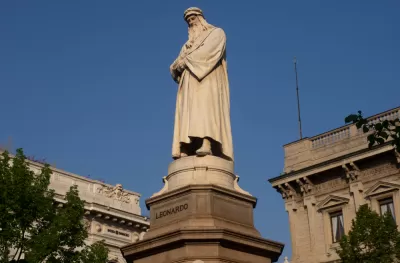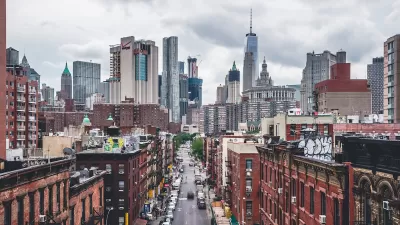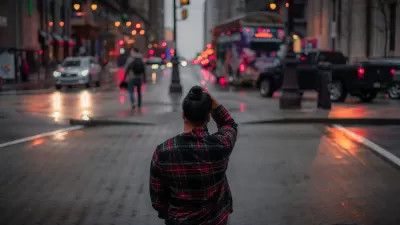Leonardo Da Vinci gets credit for many inventions and creative breakthroughs, but his contributions to the theory of city making gets less credit.

Leonardo Da Vinci died 500 years ago on May 2, and Allesandro Melis writes to describe the great thinker and artist's role in the birth of urbanism in the 15th century.
"Although the Renaissance is renown as an era of incredible progress in art and architecture, it’s rarely noted that the 15th century also marked the birth of urbanism as a true discipline," according to Melis. Da Vinci was one of the thinkers contributing to this nascent field of intellectualism. "Around 1486—after a pestilence that killed half the population in Milan—Leonardo turned his thoughts to urban planning problems. Following a typical Renaissance trend, he began to work out an 'ideal city' project, which, due to its excessive costs, would remain unfulfilled."
Melis shares a reconstruction of da Vinci's work on the subject of a new city along the Ticino River, as collected in Paris manuscript B and Codex Atlanticus. Among numerous innovative propositions, "the true originality of Leonardo’s vision was its fusion of architecture and engineering," according to Melis. "Leonardo made designs for extensive hydraulic plants to create artificial canals throughout the city. The canals, regulated by locks and basins, were supposed to make it easier for boats to navigate inland and transport goods."
"Leonardo also thought that the width of the streets ought to match the average height of the adjacent houses: a rule still followed in many contemporary cities across Italy, to allow access to sun and reduce the risk of damage from earthquakes."
Melis concludes by describing da Vinci's ideas as relevant in contemporary times, as well as models for the future of urban planning.
FULL STORY: The Urban Planning Vision of Leonardo da Vinci

Manufactured Crisis: Losing the Nation’s Largest Source of Unsubsidized Affordable Housing
Manufactured housing communities have long been an affordable housing option for millions of people living in the U.S., but that affordability is disappearing rapidly. How did we get here?

Americans May Be Stuck — But Why?
Americans are moving a lot less than they once did, and that is a problem. While Yoni Applebaum, in his highly-publicized article Stuck, gets the reasons badly wrong, it's still important to ask: why are we moving so much less than before?

Using Old Oil and Gas Wells for Green Energy Storage
Penn State researchers have found that repurposing abandoned oil and gas wells for geothermal-assisted compressed-air energy storage can boost efficiency, reduce environmental risks, and support clean energy and job transitions.

Greening Oakland’s School Grounds
With help from community partners like the Trust for Public Land, Oakland Unified School District is turning barren, asphalt-covered schoolyards into vibrant, green spaces that support outdoor learning, play, and student well-being.

California Governor Suspends CEQA Reviews for Utilities in Fire Areas
Utility restoration efforts in areas affected by the January wildfires in Los Angeles will be exempt from environmental regulations to speed up the rebuilding of essential infrastructure.

Native American Communities Prepare to Lead on Environmental Stewardship
In the face of federal threats to public lands and conservation efforts, indigenous groups continue to model nature-centered conservation efforts.
Urban Design for Planners 1: Software Tools
This six-course series explores essential urban design concepts using open source software and equips planners with the tools they need to participate fully in the urban design process.
Planning for Universal Design
Learn the tools for implementing Universal Design in planning regulations.
Heyer Gruel & Associates PA
City of Moreno Valley
Institute for Housing and Urban Development Studies (IHS)
City of Grandview
Harvard GSD Executive Education
Salt Lake City
NYU Wagner Graduate School of Public Service
City of Cambridge, Maryland





























